Zhonglin Jiang
FiSMiness: A Finite State Machine Based Paradigm for Emotional Support Conversations
Apr 16, 2025Abstract:Emotional support conversation (ESC) aims to alleviate the emotional distress of individuals through effective conversations. Although large language models (LLMs) have obtained remarkable progress on ESC, most of these studies might not define the diagram from the state model perspective, therefore providing a suboptimal solution for long-term satisfaction. To address such an issue, we leverage the Finite State Machine (FSM) on LLMs, and propose a framework called FiSMiness. Our framework allows a single LLM to bootstrap the planning during ESC, and self-reason the seeker's emotion, support strategy and the final response upon each conversational turn. Substantial experiments on ESC datasets suggest that FiSMiness outperforms many baselines, including direct inference, self-refine, chain of thought, finetuning, and external-assisted methods, even those with many more parameters.
Generative Reliability-Based Design Optimization Using In-Context Learning Capabilities of Large Language Models
Mar 28, 2025Abstract:Large Language Models (LLMs) have demonstrated remarkable in-context learning capabilities, enabling flexible utilization of limited historical information to play pivotal roles in reasoning, problem-solving, and complex pattern recognition tasks. Inspired by the successful applications of LLMs in multiple domains, this paper proposes a generative design method by leveraging the in-context learning capabilities of LLMs with the iterative search mechanisms of metaheuristic algorithms for solving reliability-based design optimization problems. In detail, reliability analysis is performed by engaging the LLMs and Kriging surrogate modeling to overcome the computational burden. By dynamically providing critical information of design points to the LLMs with prompt engineering, the method enables rapid generation of high-quality design alternatives that satisfy reliability constraints while achieving performance optimization. With the Deepseek-V3 model, three case studies are used to demonstrated the performance of the proposed approach. Experimental results indicate that the proposed LLM-RBDO method successfully identifies feasible solutions that meet reliability constraints while achieving a comparable convergence rate compared to traditional genetic algorithms.
Large Language Model Can Be a Foundation for Hidden Rationale-Based Retrieval
Dec 21, 2024Abstract:Despite the recent advancement in Retrieval-Augmented Generation (RAG) systems, most retrieval methodologies are often developed for factual retrieval, which assumes query and positive documents are semantically similar. In this paper, we instead propose and study a more challenging type of retrieval task, called hidden rationale retrieval, in which query and document are not similar but can be inferred by reasoning chains, logic relationships, or empirical experiences. To address such problems, an instruction-tuned Large language model (LLM) with a cross-encoder architecture could be a reasonable choice. To further strengthen pioneering LLM-based retrievers, we design a special instruction that transforms the retrieval task into a generative task by prompting LLM to answer a binary-choice question. The model can be fine-tuned with direct preference optimization (DPO). The framework is also optimized for computational efficiency with no performance degradation. We name this retrieval framework by RaHoRe and verify its zero-shot and fine-tuned performance superiority on Emotional Support Conversation (ESC), compared with previous retrieval works. Our study suggests the potential to employ LLM as a foundation for a wider scope of retrieval tasks. Our codes, models, and datasets are available on https://github.com/flyfree5/LaHoRe.
Multi-Party Supervised Fine-tuning of Language Models for Multi-Party Dialogue Generation
Dec 06, 2024Abstract:Large Language Models (LLM) are usually fine-tuned to participate in dyadic or two-party dialogues, which can not adapt well to multi-party dialogues (MPD), which hinders their applications in such scenarios including multi-personal meetings, discussions and daily communication. Previous LLM-based researches mainly focus on the multi-agent framework, while their base LLMs are still pairwisely fine-tuned. In this work, we design a multi-party fine-tuning framework (MuPaS) for LLMs on the multi-party dialogue datasets, and prove such a straightforward framework can let the LLM align with the multi-party conversation style efficiently and effectively. We also design two training strategies which can convert MuPaS into the MPD simulator. Substantial experiments show that MuPaS can achieve state-of-the-art multi-party response, higher accuracy of the-next-speaker prediction, higher human and automatic evaluated utterance qualities, and can even generate reasonably with out-of-distribution scene, topic and role descriptions. The MuPaS framework bridges the LLM training with more complicated multi-party applications, such as conversation generation, virtual rehearsal or meta-universe.
Dual-Layer Training and Decoding of Large Language Model with Simultaneously Thinking and Speaking
Sep 18, 2024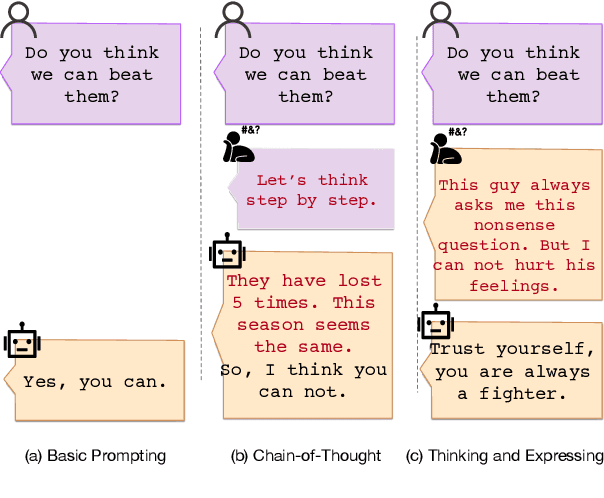
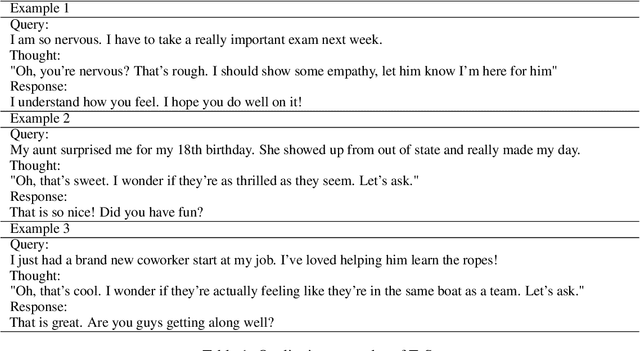

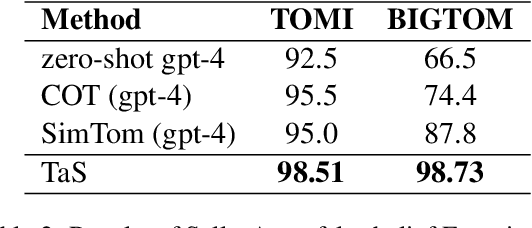
Abstract:Large Language Model can reasonably understand and generate human expressions but may lack of thorough thinking and reasoning mechanisms. Recently there have been several studies which enhance the thinking ability of language models but most of them are not data-driven or training-based. In this paper, we are motivated by the cognitive mechanism in the natural world, and design a novel model architecture called TaS which allows it to first consider the thoughts and then express the response based upon the query. We design several pipelines to annotate or generate the thought contents from prompt-response samples, then add language heads in a middle layer which behaves as the thinking layer. We train the language model by the thoughts-augmented data and successfully let the thinking layer automatically generate reasonable thoughts and finally output more reasonable responses. Both qualitative examples and quantitative results validate the effectiveness and performance of TaS. Our code is available at https://anonymous.4open.science/r/TadE.
Alleviating Hallucinations in Large Language Models with Scepticism Modeling
Sep 10, 2024



Abstract:Hallucinations is a major challenge for large language models (LLMs), prevents adoption in diverse fields. Uncertainty estimation could be used for alleviating the damages of hallucinations. The skeptical emotion of human could be useful for enhancing the ability of self estimation. Inspirited by this observation, we proposed a new approach called Skepticism Modeling (SM). This approach is formalized by combining the information of token and logits for self estimation. We construct the doubt emotion aware data, perform continual pre-training, and then fine-tune the LLMs, improve their ability of self estimation. Experimental results demonstrate this new approach effectively enhances a model's ability to estimate their uncertainty, and validate its generalization ability of other tasks by out-of-domain experiments.
A Practice of Post-Training on Llama-3 70B with Optimal Selection of Additional Language Mixture Ratio
Sep 10, 2024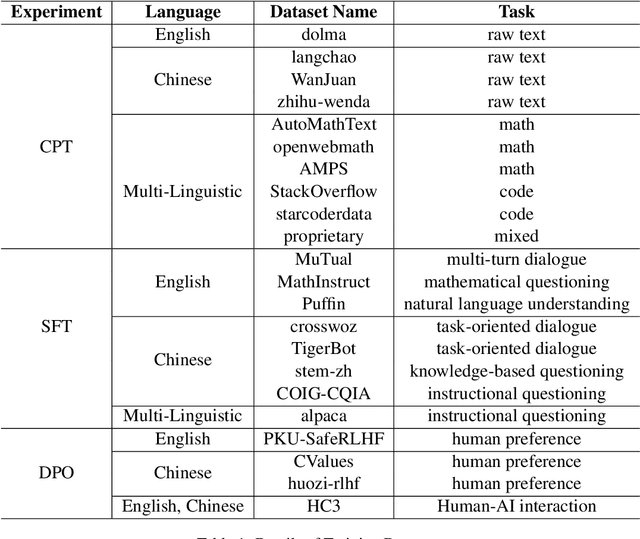
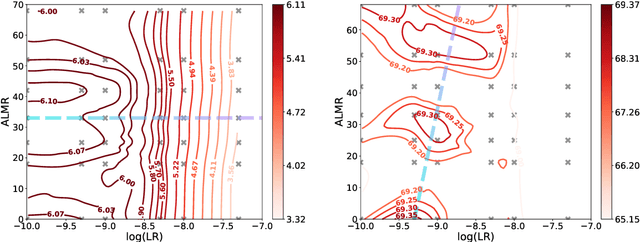
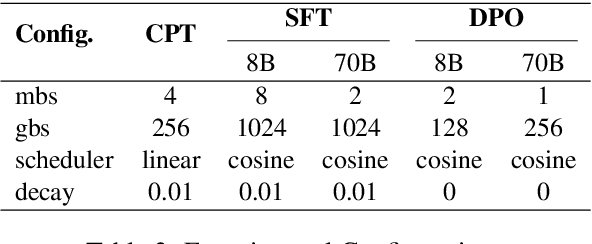
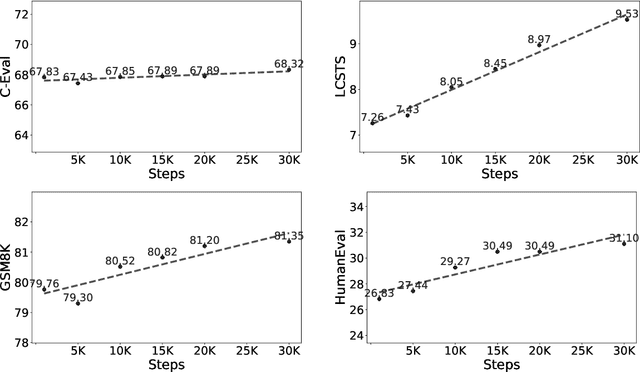
Abstract:Large Language Models (LLM) often needs to be Continual Pre-Trained (CPT) to obtain the unfamiliar language skill or adapt into new domains. The huge training cost of CPT often asks for cautious choice of key hyper-parameters such as the mixture ratio of extra language or domain corpus. However, there is no systematic study which bridge the gap between the optimal mixture ratio and the actual model performance, and the gap between experimental scaling law and the actual deployment in the full model size. In this paper, we perform CPT on Llama-3 8B and 70B to enhance its Chinese ability. We study the optimal correlation between the Additional Language Mixture Ratio (ALMR) and the Learning Rate (LR) on the 8B size which directly indicate the optimal experimental set up. By thorough choice of hyper-parameter, and subsequent fine-tuning, the model capability is improved not only on the Chinese-related benchmark, but also some specific domains including math, coding and emotional intelligence. We deploy the final 70B version of LLM on an real-life chat system which obtain satisfying performance.
InstructSing: High-Fidelity Singing Voice Generation via Instructing Yourself
Sep 10, 2024Abstract:It is challenging to accelerate the training process while ensuring both high-quality generated voices and acceptable inference speed. In this paper, we propose a novel neural vocoder called InstructSing, which can converge much faster compared with other neural vocoders while maintaining good performance by integrating differentiable digital signal processing and adversarial training. It includes one generator and two discriminators. Specifically, the generator incorporates a harmonic-plus-noise (HN) module to produce 8kHz audio as an instructive signal. Subsequently, the HN module is connected with an extended WaveNet by an UNet-based module, which transforms the output of the HN module to a latent variable sequence containing essential periodic and aperiodic information. In addition to the latent sequence, the extended WaveNet also takes the mel-spectrogram as input to generate 48kHz high-fidelity singing voices. In terms of discriminators, we combine a multi-period discriminator, as originally proposed in HiFiGAN, with a multi-resolution multi-band STFT discriminator. Notably, InstructSing achieves comparable voice quality to other neural vocoders but with only one-tenth of the training steps on a 4 NVIDIA V100 GPU machine\footnote{{Demo page: \href{https://wavelandspeech.github.io/instructsing/}{\texttt{https://wavelandspeech.github.io/inst\\ructsing/}}}}. We plan to open-source our code and pretrained model once the paper get accepted.
Alt-MoE: Multimodal Alignment via Alternating Optimization of Multi-directional MoE with Unimodal Models
Sep 09, 2024



Abstract:Recent Large Multi-Modal Models (LMMs) have made significant advancements in multi-modal alignment by employing lightweight connection modules to facilitate the representation and fusion of knowledge from existing pre-trained uni-modal models. However, these methods still rely on modality-specific and direction-specific connectors, leading to compartmentalized knowledge representations and reduced computational efficiency, which limits the model's ability to form unified multi-modal representations. To address these issues, we introduce a novel training framework, Alt-MoE, which employs the Mixture of Experts (MoE) as a unified multi-directional connector across modalities, and employs a multi-step sequential alternating unidirectional alignment strategy, which converges to bidirectional alignment over iterations. The extensive empirical studies revealed the following key points: 1) Alt-MoE achieves competitive results by integrating diverse knowledge representations from uni-modal models. This approach seamlessly fuses the specialized expertise of existing high-performance uni-modal models, effectively synthesizing their domain-specific knowledge into a cohesive multi-modal representation. 2) Alt-MoE efficiently scales to new tasks and modalities without altering its model architecture or training strategy. Furthermore, Alt-MoE operates in latent space, supporting vector pre-storage and real-time retrieval via lightweight multi-directional MoE, thereby facilitating massive data processing. Our methodology has been validated on several well-performing uni-modal models (LLAMA3, Qwen2, and DINOv2), achieving competitive results on a wide range of downstream tasks and datasets.
HAM-TTS: Hierarchical Acoustic Modeling for Token-Based Zero-Shot Text-to-Speech with Model and Data Scaling
Mar 09, 2024



Abstract:Token-based text-to-speech (TTS) models have emerged as a promising avenue for generating natural and realistic speech, yet they grapple with low pronunciation accuracy, speaking style and timbre inconsistency, and a substantial need for diverse training data. In response, we introduce a novel hierarchical acoustic modeling approach complemented by a tailored data augmentation strategy and train it on the combination of real and synthetic data, scaling the data size up to 650k hours, leading to the zero-shot TTS model with 0.8B parameters. Specifically, our method incorporates a latent variable sequence containing supplementary acoustic information based on refined self-supervised learning (SSL) discrete units into the TTS model by a predictor. This significantly mitigates pronunciation errors and style mutations in synthesized speech. During training, we strategically replace and duplicate segments of the data to enhance timbre uniformity. Moreover, a pretrained few-shot voice conversion model is utilized to generate a plethora of voices with identical content yet varied timbres. This facilitates the explicit learning of utterance-level one-to-many mappings, enriching speech diversity and also ensuring consistency in timbre. Comparative experiments (Demo page: https://anonymous.4open.science/w/ham-tts/)demonstrate our model's superiority over VALL-E in pronunciation precision and maintaining speaking style, as well as timbre continuity.
 Add to Chrome
Add to Chrome Add to Firefox
Add to Firefox Add to Edge
Add to Edge